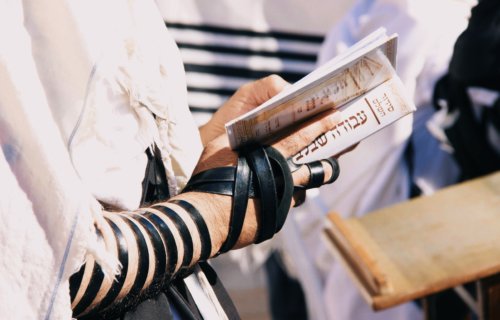CINCINNATI — Jewish men who wear tefillin while praying may be receiving an added benefit from the practice — better heart health! Researchers from the University of Cincinnati explain that those who tightly wrap the leather bands around their arm during prayer may protect themselves against severe cardiovascular damage after a heart attack.
“Tefillin is used for morning prayers for Jewish men over the age of 13 on an almost daily basis,” says Jack Rubinstein, MD, of the Division of Cardiovascular Health in the UC College of Medicine, in a university release. “It is placed on the nondominant arm around the bicep and the forearm in a fairly tight manner. It is never worn in a fashion as to occlude the blood flow. This is traditionally worn for about 30 minutes continuously during prayers which involve sitting and standing resulting in occasional retightening of the strap around your arm.”
Tefillin has been an integral part of the Jewish religion since ancient times, when commandments called on followers to abide by religious laws. Tefillin represents a physical act of attaching the laws to oneself, or to “bind them as a sign upon your arm.”
Rubinstein says doing this brings a level of discomfort that may confer protection against damage resulting from a sudden loss of blood flow (acute ischemia), or after blood supply is restored (reperfusion). This generally occurs during a heart attack. When this happens, part of the heart no longer receives oxygen due to the stoppage of blood flow and then suffers further once flow is restored.
The practice may protect a person’s fight-or-flight response
Rubinstein and team measured baseline information and heart rate in 30 participants between the ages 18 and 40 for 10 minutes in the morning. They gathered more data during and after 30 minutes of wearing tefillin. Their findings may pave the way for improving preventive cardiovascular care.
“What we found is that wearing tefillin in both male and females caused changes to the heart rate associated with lowering of the metabolism as measured via heart rate variability,” says Rubinstein, who explains that heart rate variability refers to the difference between one heartbeat and the next heartbeat. “We can measure all kinds of different things from heart rate variability including probably the most important which is parasympathetic tone. Does it relax you and does it cause your metabolism [to] come down?”
The parasympathetic and sympathetic nervous systems describe the “fight-or-flight” system in our bodies. The parasympathetic system carries signals that tell the body to relax, while the sympathetic system does the opposite. They are both integral to maintaining proper balance in the body. Rubinstein says that tefillin had a significant effect, and thus this work presents an idea that could completely take cardiovascular care to the next level — for both men and women.
“You have a very common and very deadly disease. We are showing a path through which anyone can precondition themselves to decrease the amount of damage that they suffer from a heart attack by wearing a very simple device,” Rubinstein concludes. “This is a potential game changer for how we approach cardiovascular disease prevention. Decreasing the amount of heart attack damage by even just two-fold is something that will change outcomes for millions of people.”
The findings are published in the journal PLOS ONE.

